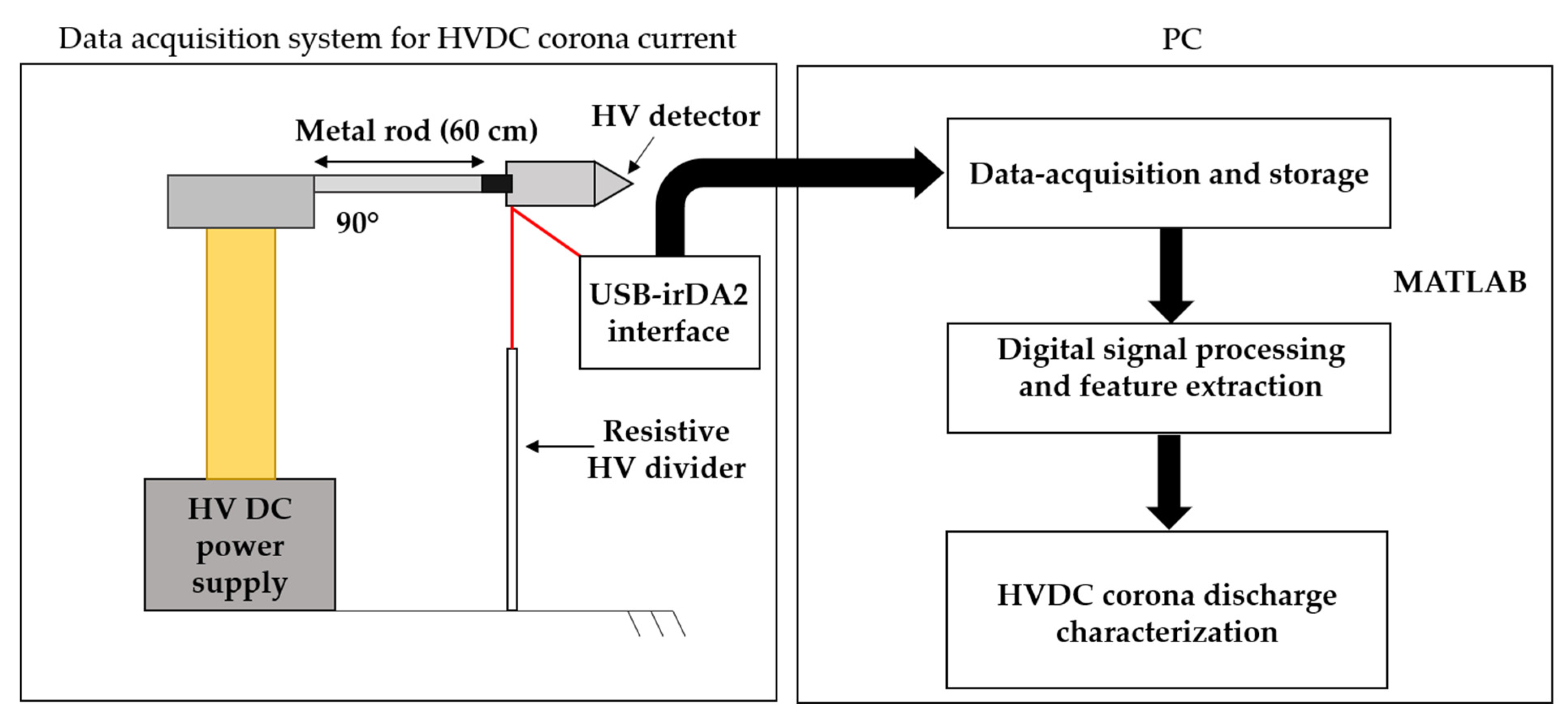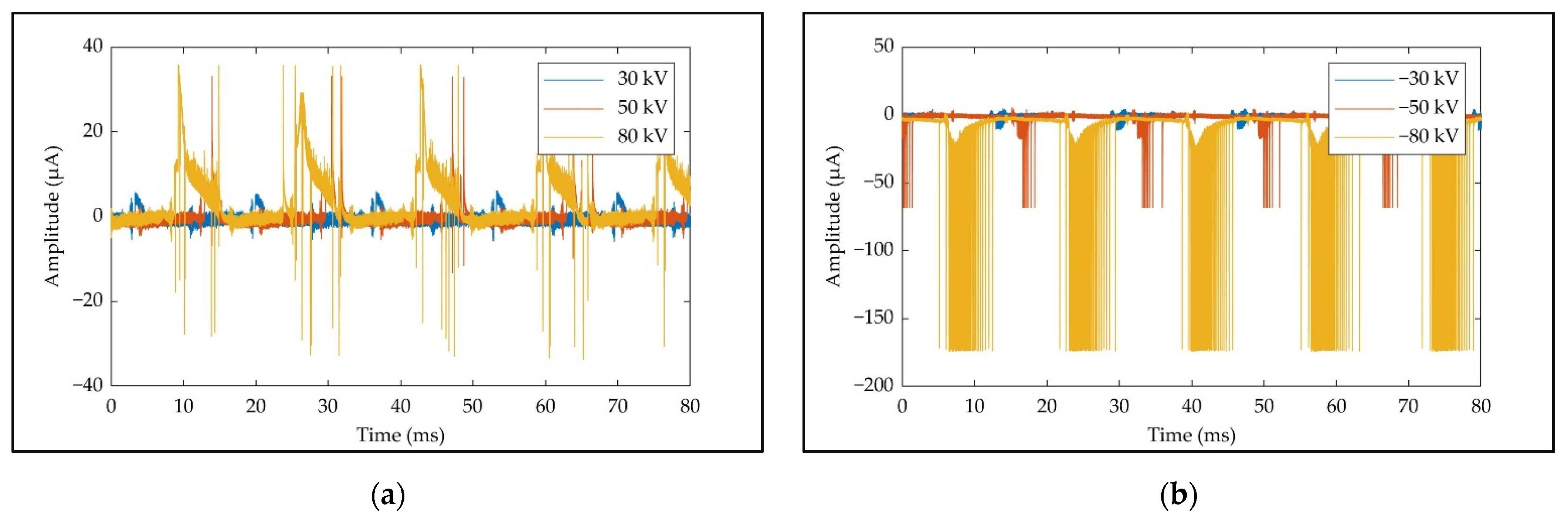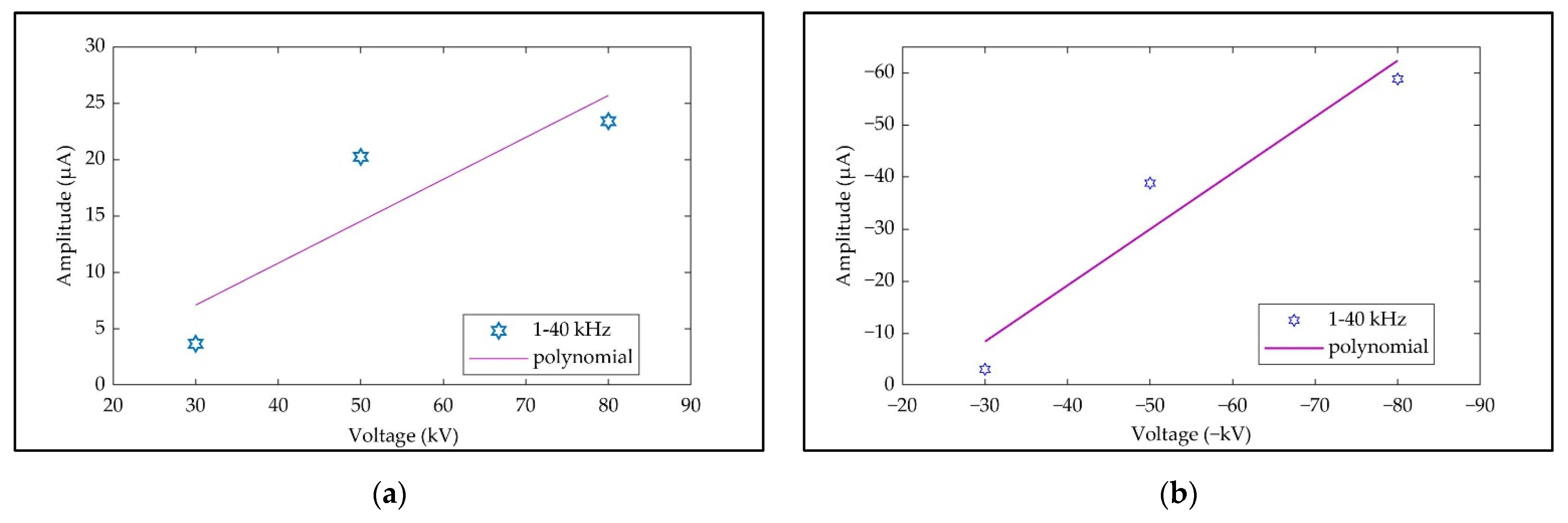A Feasibility Study of the Application of Signal Processing Techniques to Corona Discharge Characterization on HVDC Systems †
Abstract
1. Introduction
2. Experimental Setup
3. Results and Discussion
3.1. Time-Domain Analysis
3.2. Frequency Domain Analysis
3.3. Statistical Analysis
4. Conclusions
Author Contributions
Funding
Institutional Review Board Statement
Informed Consent Statement
Data Availability Statement
Acknowledgments
Conflicts of Interest
References
- Ghislain Ogoulola, C.E.; Junqueira Rezek, A.J.; Fifatin, F.; Silva, V.Z.; Gonzatti, R.B.; de Oliveira, J.C.; Di Lorenzo Correa, R. An alternative proposal for HVDC transmission systems using 24-pulse AC/DC converters based on three-winding non-conventional transformers. Electr. Power Syst. Res. 2020, 182, 106230. [Google Scholar] [CrossRef]
- Alassi, A.; Bañales, S.; Ellabban, O.; Adam, G.; MacIver, C. HVDC Transmission: Technology Review, Market Trends and Future Outlook. Renew. Sustain. Energy Rev. 2019, 112, 530–554. [Google Scholar] [CrossRef]
- Tosatto, A.; Weckesser, T.; Chatzivasileiadis, S. Market Integration of HVDC Lines: Internalizing HVDC Losses in Market Clearing. IEEE Trans. Power Syst. 2020, 35, 451–461. [Google Scholar] [CrossRef]
- Cui, Y.; Yuan, H.; Song, X.; Zhao, L.; Liu, Y.; Lin, L. Model, Design, and Testing of Field Mill Sensors for Measuring Electric Fields under High-Voltage Direct-Current Power Lines. IEEE Trans. Ind. Electron. 2018, 65, 608–615. [Google Scholar] [CrossRef]
- Wijeweera, G.; Bahreyni, B.; Shafai, C.; Rajapakse, A.; Swatek, D.R. Micromachined Electric-Field Sensor to Measure AC and DC Fields in Power Systems. IEEE Trans. Power Deliv. 2009, 24, 988–995. [Google Scholar] [CrossRef]
- Xin, E.; Yuan, H. Development of a sensor for corona current measurement under high-voltage direct-current transmission lines. Int. J. Distrib. Sens. Netw. 2016, 12, 155014771666424. [Google Scholar] [CrossRef][Green Version]
- Suo, C.; Sun, H.; Zhang, W.; Zhou, N.; Chen, W. Adaptive Safety Early Warning Device for Non-contact Measurement of HVDC Electric Field. Electronics 2020, 9, 329. [Google Scholar] [CrossRef]
- Otto, A.J.; Reader, H.C. Wideband and Narrowband HVDC Conductor Corona Test Methods for Radio Noise Prediction. IEEE Trans. Power Deliv. 2010, 25, 2950–2957. [Google Scholar] [CrossRef]
- Yuan, H.; Yang, Q.; Liu, Y.; Lu, J.; Akhtar, S.A. Development and Application of High-Frequency Sensor for Corona Current Measurement under Ultra High-Voltage Direct-Current Environment. IEEE Trans. Instrum. Meas. 2012, 61, 1064–1071. [Google Scholar] [CrossRef]
- Zhu, L.; Liu, S.H.; Zhang, Y.; Huang, F.Y.; Zhu, H.J. Design of Sensor for Detecting Corona Discharge Signal in Specific Band. Appl. Mech. Mater. 2013, 336–338, 158–162. [Google Scholar] [CrossRef]
- Liu, Y.; Yuan, H.; Yang, Q.; Cui, Y. Design of the corona current measurement sensor with wide bandwidth under dc ultra-high-voltage environment. Meas. Sci. Technol. 2011, 22, 125202. [Google Scholar] [CrossRef]
- Zhu, K.; Lee, W.K.; Pong, P.W. Non-Contact Voltage Monitoring of HVDC Transmission Lines Based on Electromagnetic Fields. IEEE Sens. J. 2019, 19, 3121–3129. [Google Scholar] [CrossRef]
- Zou, Z.; Li, D.; Xu, J.; Cui, X.; Lu, T.; Bian, X. Impact of fine particles on the direct current electric field of the conductor due to corona discharge. J. Electrost. 2017, 88, 106–110. [Google Scholar] [CrossRef]
- Kantouna, K.; Ekonomou, L.; Fotis, G.P.; Chatzarakis, G.E. Finite element method analysis of an electric field in wire-cylinder electrode configuration during corona discharge. In Proceedings of the 11th WSEAS International Conference on System Science and Simulation in Engineering (ICOSSSE’12), Singapore City, Singapore, 11–13 May 2012; pp. 97–103. [Google Scholar]
- Abouelatta, M.A.; Ward, S.A.; Sayed, A.M.; Mahmoud, K.; Lehtonen, M.; Darwish, M.M. Measurement and assessment of corona current density for HVDC bundle conductors by FDM integrated with full multigrid technique. Electr. Power Syst. Res. 2021, 199, 107370. [Google Scholar] [CrossRef]
- Liu, Y.; Xv, J.; Liu, Y.; Yuan, H.; Cui, Y. A Method for the Indirect Detection of Audible Noise from High-Voltage Direct Current Transmission Lines. IEEE Trans. Instrum. Meas. 2020, 69, 4358–4369. [Google Scholar] [CrossRef]
- Kantouna, K.; Fotis, G.P.; Kiousis, K.N.; Ekonomou, L.; Chatzarakis, G.E. Analysis of a cylinder-wire-cylinder electrode configuration during corona discharge. In Proceedings of the Circuits, Systems, Communications, Computers and Applications (CSCCA), WSEAS, Iasi, Romania, 13–15 June 2012; pp. 204–208. [Google Scholar]
- Önal, E. Corona Identification of Impulse Voltage and Current. Electrica 2018, 18, 78–82. [Google Scholar] [CrossRef]
- Al-geelani, N.A.; Piah, M.A.M.; Abdul-Malek, Z. Identification of acoustic signals of corona discharges under different contamination levels using wavelet transform. Electr. Eng. 2018, 100, 1059–1067. [Google Scholar] [CrossRef]
- Wahyudi, M.; Tumiran, T.; Negara, I.M.Y.; Setiawan, N.A.; Sugiyantoro, B. Audiosonic Acoustic Detection of Air Corona Discharge based on Fast Fourier Transform. In Proceedings of the 2019 2nd International Conference on High Voltage Engineering and Power Systems (ICHVEPS), Bali, Indonesia, 1–4 October 2019; pp. 1–6. [Google Scholar]
- Ardila-Rey, J.A.; Cerda-Luna, M.P.; Rozas-Valderrama, R.A.; de Castro, B.A.; Andreoli, A.L.; Muhammad-Sukki, F. Separation techniques of partial discharges and electrical noise sources: A review of recent progress. IEEE Access 2020, 8, 199449–199461. [Google Scholar] [CrossRef]




Publisher’s Note: MDPI stays neutral with regard to jurisdictional claims in published maps and institutional affiliations. |
© 2021 by the authors. Licensee MDPI, Basel, Switzerland. This article is an open access article distributed under the terms and conditions of the Creative Commons Attribution (CC BY) license (https://creativecommons.org/licenses/by/4.0/).
Share and Cite
David, G.A.; Junior, P.O.C.; Dotto, F.R.L.; Santos, B.R. A Feasibility Study of the Application of Signal Processing Techniques to Corona Discharge Characterization on HVDC Systems. Eng. Proc. 2021, 10, 28. https://doi.org/10.3390/ecsa-8-11318
David GA, Junior POC, Dotto FRL, Santos BR. A Feasibility Study of the Application of Signal Processing Techniques to Corona Discharge Characterization on HVDC Systems. Engineering Proceedings. 2021; 10(1):28. https://doi.org/10.3390/ecsa-8-11318
Chicago/Turabian StyleDavid, Gabriel Augusto, Pedro Oliveira Conceição Junior, Fabio Romano Lofrano Dotto, and Benedito Roberto Santos. 2021. "A Feasibility Study of the Application of Signal Processing Techniques to Corona Discharge Characterization on HVDC Systems" Engineering Proceedings 10, no. 1: 28. https://doi.org/10.3390/ecsa-8-11318
APA StyleDavid, G. A., Junior, P. O. C., Dotto, F. R. L., & Santos, B. R. (2021). A Feasibility Study of the Application of Signal Processing Techniques to Corona Discharge Characterization on HVDC Systems. Engineering Proceedings, 10(1), 28. https://doi.org/10.3390/ecsa-8-11318







